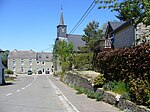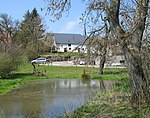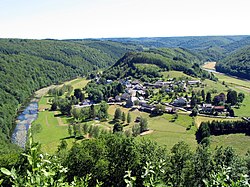Brasserie d'Achouffe
Beer brandsBreweries of WalloniaHouffalizeOrganisations based in Luxembourg (Belgium)

The Brasserie d'Achouffe is a Belgian brewery based in Achouffe. It was founded in 1982 by two brothers-in-law, Pierre Gobron and Christian Bauweraerts, as a hobby. In September 2006, the brewery was sold to the Duvel Moortgat brewery group.
Excerpt from the Wikipedia article Brasserie d'Achouffe (License: CC BY-SA 3.0, Authors, Images).Brasserie d'Achouffe
Achouffe,
Geographical coordinates (GPS) Address Phone number Website External links Nearby Places Show on map
Geographical coordinates (GPS)
| Latitude | Longitude |
|---|---|
| N 50.1509 ° | E 5.7456 ° |
Address
Brasserie d'Achouffe
Achouffe 32
6666
Luxembourg, Belgium
Open on Google Maps









